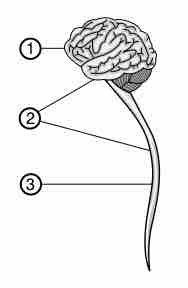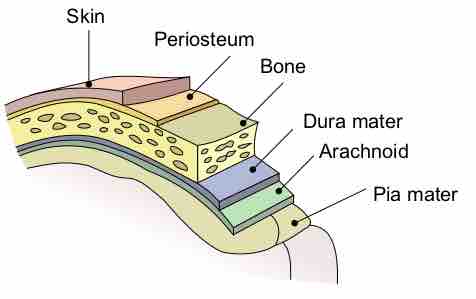Introduction to the Nervous System
The nervous system of higher vertebrates (the group that includes humans) is a widely-distributed communication and processing network that serves controlling functions over other organ systems. It possesses a key function in the orientation of the individual; controls its behavior, motor function, and sensory processing; and contains mechanisms to store information. A classification of the nervous system can be performed under different aspects. The anatomical compartmentalization of its components defines the classical approach. Two major divisions of the nervous system are the central nervous system (CNS) and the peripheral nervous system (PNS).
Central Nervous System
The vertebrate central nervous system (CNS) contains the brain and the spinal cord . The brain contains structurally- and functionally-defined regions. In mammals, these include the cortex (which can be broken down into four primary functional lobes: frontal, temporal, occipital, and parietal), basal ganglia, thalamus, hypothalamus, limbic system, cerebellum, and brainstem; although structures in some of these designations overlap. While functions may be primarily localized to one structure in the brain, most complex functions, such as language and sleep, involve neurons in multiple brain regions. The spinal cord is the information superhighway, connecting the brain with the rest of the body through the peripheral nerves. It transmits sensory and motor input and also controls motor reflexes.

Central nervous system
The central nervous system (2) is a combination of the brain (1) and the spinal cord (3).
The CNS is covered with three layers of protective coverings called meninges (from the Greek word for membrane) . The outermost layer is the dura mater (Latin for "hard mother"). As the Latin name suggests, the primary function for this thick layer is to protect the brain and spinal cord. The dura mater also contains vein-like structures that carry blood from the brain back to the heart. The middle layer is the web-like arachnoid mater. The last layer is the pia mater (Latin for "soft mother"), which directly contacts and covers the brain and spinal cord like plastic wrap. The space between the arachnoid and pia maters is filled with cerebrospinal fluid (CSF). CSF is produced by a tissue called the choroid plexus in fluid-filled compartments in the CNS called ventricles. The brain floats in CSF, which acts as a cushion and shock absorber, making the brain neutrally buoyant. CSF also functions to circulate chemical substances throughout the brain and into the spinal cord.

Meninges of the brain
The outermost layer of the meninges is the dura mater, which protects the brain and spinal cord. The innermost layer is the pia mater, which directly covers the brain and spinal cord. The arachnoid mater is found between the two.
Peripheral Nervous System
The peripheral nervous system consists of nerves that are connected to the brain (cranial nerves) and nerves that are connected to the spinal cord (spinal nerves). The main function of the PNS is to connect the central nervous system (CNS) to the limbs and organs, essentially serving as a communication relay between the brain and the extremities. Unlike the CNS, the PNS is not protected by the bone of spine and skull. Nor does it have a barrier between itself and the blood, leaving it exposed to toxins and mechanical injuries.
The autonomic nervous system, also part of the peripheral nervous system, controls internal body functions that are not under conscious control. For example, when a prey animal is chased by a predator, the autonomic nervous system automatically increases the rate of breathing and the heartbeat. It dilates the blood vessels that carry blood to the muscles, releases glucose from the liver, and makes other adjustments to provide for the sudden increase in activity. When the animal has escaped and is safe once again, the nervous system slows down all these processes and resumes all the normal body activities, such as the digestion of food.